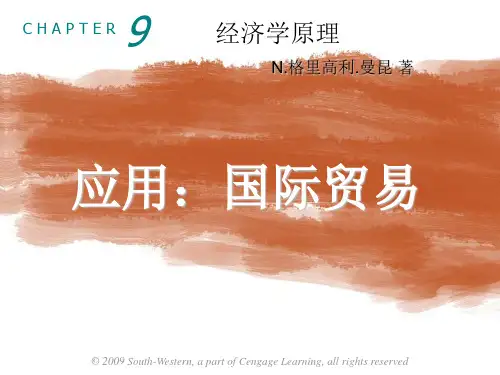曼昆微观经济学第五版 第十六章 课文PPT英文版
- 格式:ppt
- 大小:527.00 KB
- 文档页数:50

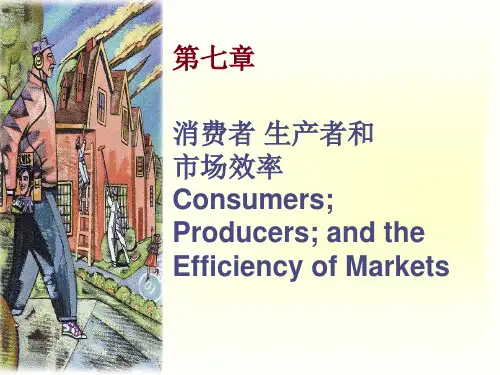
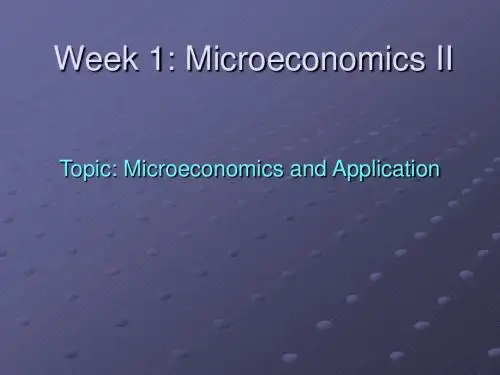
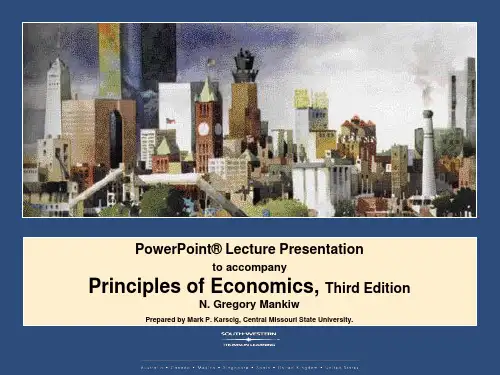
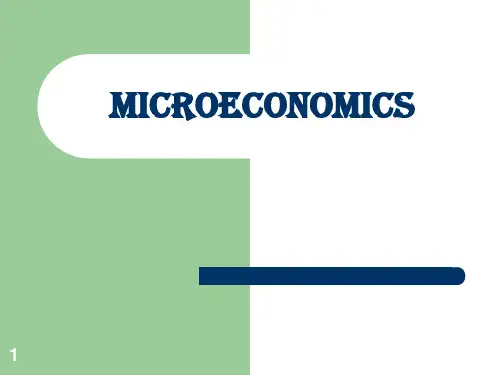
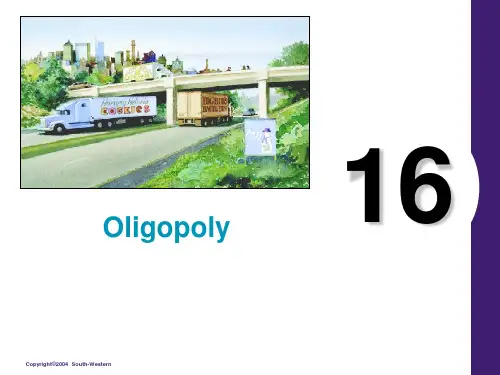
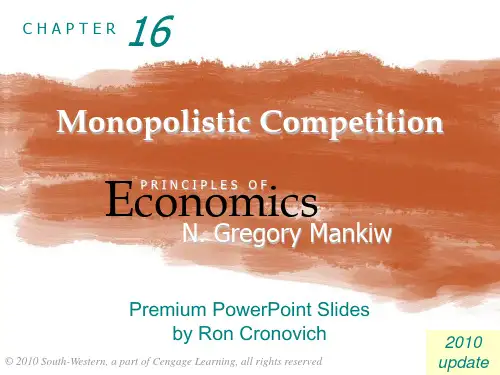
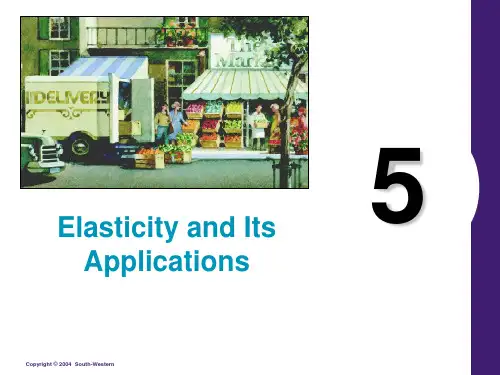
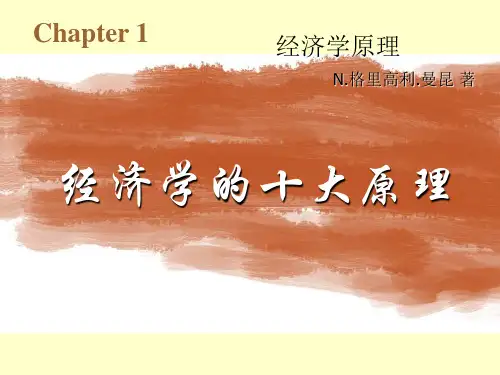
![曼昆《微观经济学》答案(英文版)_Chapter_1~5[1]](https://uimg.taocdn.com/c2b43437eefdc8d376ee3296.webp)
Chapter 1Problems and Applications1. a. A family deciding whether to buy a new car faces a tradeoff between the cost of thecar and other things they might want to buy. For example, buying the car mightmean they must give up going on vacation for the next two years. So the real costof the car is the family's opportunity cost in terms of what they must give up.b. For a member of Congress deciding whether to increase spending on national parks,the tradeoff is between parks and other spending items or tax cuts. If more moneygoes into the park system, that may mean less spending on national defense or on thepolice force. Or, instead of spending more money on the park system, taxes couldbe reduced.c. When a company president decides whether to open a new factory, the decision isbased on whether the new factory will increase the firm's profits compared to otheralternatives. For example, the company could upgrade existing equipment orexpand existing factories. The bottom line is: Which method of expandingproduction will increase profit the most?d. In deciding how much to prepare for class, a professor faces a tradeoff between thevalue of improving the quality of the lecture compared to other things she could dowith her time, such as working on additional research.2. When the benefits of something are psychological, such as going on a vacation, it isn't easy tocompare benefits to costs to determine if it's worth doing. But there are two ways to think about the benefits. One is to compare the vacation with what you would do in its place. If you didn't go on vacation, would you buy something like a new set of golf clubs? Then you can decide if you'd rather have the new clubs or the vacation. A second way is to think about how much work you had to do to earn the money to pay for the vacation; then you can decide if the psychological benefits of the vacation were worth the psychological cost of working.3. If you are thinking of going skiing instead of working at your part-time job, the cost of skiingincludes its monetary and time costs, plus the opportunity cost of the wages you're giving up by not working. If the choice is between skiing and going to the library to study, then the cost of skiing is its monetary and time costs plus the cost to you of getting a lower grade in your course.4. If you spend $100 now instead of investing it for a year and earning 5 percent interest, youare giving up the opportunity to spend $105 a year from now. The idea that money has a time value is the basis for the field of finance, the subfield of economics that has to do with prices of financial instruments like stocks and bonds.5. The fact that you've already sunk $5 million isn't relevant to your decision anymore, sincethat money is gone. What matters now is the chance to earn profits at the margin. If you spend another $1 million and can generate sales of $3 million, you'll earn $2 million in marginal profit, so you should do so. You are right to think that the project has lost a total of $3 million ($6 million in costs and only $3 million in revenue) and you shouldn't have started it. That's true, but if you don't spend the additional $1 million, you won't have any sales and your losses will be $5 million. So what matters is not the total profit, but the profit you can earn at the margin. In fact, you'd pay up to $3 million to complete development; any more than that, and you won't be increasing profit at the margin.6. Harry suggests looking at whether productivity would rise or fall. Productivity is certainlyimportant, since the more productive workers are, the lower the cost per gallon of potion.Harry wants to look at average cost. But both Harry and Ron are missing the other side of the equation−revenue. A firm wants to maximize its profits, so it needs to examine both costs and revenues. Thus, Hermione is right−it’s best to examine whether the extra revenue would exceed the extra costs. In addition, Hermione is the only one who’s thinking at the margin.7. a. Since a person gets fewer after-tax Social Security benefits the greater is his or herincome, there's an incentive not to save for retirement. If you save a lot, yourincome will be higher, and you won't get as much after-tax Social Security income assomeone who didn't save as much. The unintended consequence of the taxation ofSocial Security benefits is to reduce saving; yet the Social Security system arosebecause of worries that people wouldn’t save enough for retirement.b. For the same reason, you'll tend not to work (or not work as much) after age 65.The more you work, the lower your after-tax Social Security benefits will be. Thusthe taxation of Social Security benefits discourages work effort after age 65.8. a. When welfare recipients who are able to work have their benefits cut off after twoyears, they have greater incentive to find jobs than if their benefits were to lastforever.b. The loss of benefits means that someone who can't find a job will get no income atall, so the distribution of income will become less equal. But the economy will bemore efficient, since welfare recipients have a greater incentive to find jobs. Thusthe change in the law is one that increases efficiency but reduces equity.9. By specializing in each task, you and your roommate can finish the chores more quickly. Ifyou divided each task equally, it would take you more time to cook than it would take your roommate, and it would take him more time to clean than it would take you. By specializing, you reduce the total time spent on chores.Similarly, countries can specialize and trade, making both better off. For example, suppose it takes Spanish workers less time to make clothes than French workers, and French workers can make wine more efficiently than Spanish workers. Then Spain and France can both benefit if Spanish workers produce all the clothes and French workers produce all the wine, and they exchange some wine for some clothes.10. a. Being a central planner is tough! To produce the right number of CDs by the rightartists and deliver them to the right people requires an enormous amount ofinformation. You need to know about production techniques and costs in the CDindustry. You need to know each person's musical tastes and which artists theywant to hear. If you make the wrong decisions, you'll be producing too many CDsby artists that people don't want to hear, and not enough by others.b. Your decisions about how many CDs to produce carry over to other decisions. Youhave to make the right number of CD players for people to use. If you make toomany CDs and not enough cassette tapes, people with cassette players will be stuckwith CDs they can't play. The probability of making mistakes is very high. Youwill also be faced with tough choices about the music industry compared to otherparts of the economy. If you produce more sports equipment, you'll have fewerresources for making CDs. So all decisions about the economy influence yourdecisions about CD production.11. a. Efficiency: The market failure comes from the monopoly by the cable TV firm.b. Equityc. Efficiency: An externality arises because secondhand smoke harms nonsmokers.d. Efficiency: The market failure occurs because of Standard Oil's monopoly power.e. Equityf. Efficiency: There's an externality because of accidents caused by drunk drivers.12. a. If everyone were guaranteed the best health care possible, much more of our nation'soutput would be devoted to medical care than is now the case. Would that beefficient? If you think that currently doctors form a monopoly and restrict healthcare to keep their incomes high, you might think efficiency would increase byproviding more health care. But more likely, if the government mandated increasedspending on health care, the economy would be less efficient because it would givepeople more health care than they would choose to pay for. From the point of viewof equity, if poor people are less likely to have adequate health care, providing morehealth care would represent an improvement. Each person would have a more evenslice of the economic pie, though the pie would consist of more health care and lessof other goods.b. When workers are laid off, equity considerations argue for the unemploymentbenefits system to provide them with some income until they can find new jobs.After all, no one plans to be laid off, so unemployment benefits are a form ofinsurance. But there’s an efficiency problem why work if you can get income fordoing nothing? The economy isn’t o perating efficiently if people remainunemployed for a long time, and unemployment benefits encourage unemployment.Thus, there’s a tradeoff between equity and efficiency. The more generous areunemployment benefits, the less income is lost by an unemployed person, but themore that person is encouraged to remain unemployed. So greater equity reducesefficiency.13. Since average income in the United States has roughly doubled every 35 years, we are likelyto have a better standard of living than our parents, and a much better standard of living than our grandparents. This is mainly the result of increased productivity, so that an hour of work produces more goods and services than it used to. Thus incomes have continuously risen over time, as has the standard of living.14. If Americans save more and it leads to more spending on factories, there will be an increasein production and productivity, since the same number of workers will have more equipment to work with. The benefits from higher productivity will go to both the workers, who will get paid more since they're producing more, and the factory owners, who will get a return on their investments. There's no such thing as a free lunch, though, because when people save more, they're giving up spending. They get higher incomes at the cost of buying fewer goods.15. a. If people have more money, they're probably going to spend more on goods andservices.b. If prices are sticky, and people spend more on goods and services, then output mayincrease, as producers increase output to meet the higher demand rather than raisingprices.c. If prices can adjust, then people's higher spending will be matched with increasedprices, and output won't rise.16. To make an intelligent decision about whether to reduce inflation, a policymaker would needto know what causes inflation and unemployment, as well as what determines the tradeoff between them. Because prices are sticky, an attempt to reduce inflation will lead to higher unemployment. A policymaker thus faces a tradeoff between the benefits of lower inflation compared to the cost of higher unemployment.Chapter 2Problems and Applications1. Many answers are possible.2. a. Steel is a fairly uniform commodity, though some firms produce steel of inferiorquality.b. Novels are each unique, so they are quite distinguishable.c. Wheat produced by one farmer is completely indistinguishable from wheat producedby another.d. Fast food is more distinguishable than steel or wheat, but certainly not as much asnovels.3. See Figure 2-5; the four transactions are shown.Figure 2-54. a. Figure 2-6 shows a production possibilities frontier between guns and butter. It isbowed out because when most of the economy’s resources are being used to pr oducebutter, the frontier is steep and when most of the economy’s resources are being usedto produce guns, the frontier is very flat. When the economy is producing a lot ofguns, workers and machines best suited to making butter are being used to makeguns, so each unit of guns given up yields a large increase in the production of butter;thus the production possibilities frontier is flat. When the economy is producing alot of butter, workers and machines best suited to making guns are being used tomake butter, so each unit of guns given up yields a small increase in the productionof butter; thus the production possibilities frontier is steep.b. Point A is impossible for the economy to achieve; it is outside the productionpossibilities frontier. Point B is feasible but inefficient because it’s inside theproduction possibilities frontier.Figure 2-6c. The Hawks might choose a point like H, with many guns and not much butter. TheDoves might choose a point like D, with a lot of butter and few guns.d. If both Hawks and Doves reduced their desired quantity of guns by the same amount,the Hawks would get a bigger peace dividend because the production possibilitiesfrontier is much steeper at point H than at point D. As a result, the reduction of agiven number of guns, starting at point H, leads to a much larger increase in thequantity of butter produced than when starting at point D.5. See Figure 2-7. The shape and position of the frontier depend on how costly it is to maintaina clean environment the productivity of the environmental industry. Gains inenvironmental productivity, such as the development of a no-emission auto engine, lead to shifts of the production-possibilities frontier, like the shift from PPF1 to PPF2 shown in the figure.Figure 2-76. a. A family’s decision about how much income to save is microeconomics.b. The effect of government regulations on auto emissions is microeconomics.c. The impact of higher saving on economic growth is macroeconomics.d. A f irm’s decision about how many workers to hire is microeconomics.e. The relationship between the inflation rate and changes in the quantity of money ismacroeconomics.7. a. The statement that society faces a short-run tradeoff between inflation andunemployment is a positive statement. It deals with how the economy is, not how itshould be. Since economists have examined data and found that there’s a short-runnegative relationship between inflation and unemployment, the statement is a fact,thus it’s a positive statement.b. The statement that a reduction in the rate of growth of money will reduce the rate ofinflation is a positive statement. Economists have found that money growth andinflation are very closely related. The statement thus tells how the world is, and soit is a positive statement.c. The statement that the Federal Reserve should reduce the rate of growth of money isa normative statement. It states an opinion about something that should be done,not how the world is.d. The statement that society ought to require welfare recipients to look for jobs is anormative statement. It doesn’t state a fact about how the world is. Instead, it is astatement of how the world should be and is thus a normative statement.e. The statement that lower tax rates encourage more work and more saving is apositive statement. Economists have studied the relationship between tax rates andwork, as well as the relationship between tax rates and saving. They’ve found anegative relationship in both cases. So the statement reflects how the world is, andis thus a positive statement.8. Two of the statements in Table 2-2 are clearly normative. They are: “5. If the federalbudget is to be balanced, it should be done over the business cycle rather th an yearly” and “9.The government should restructure the welfare system along the lines of a ‘negative income tax.’” Both are suggestions of changes that should be made, rather than statements of fact, so they are clearly normative statements.The other statements in the table are positive. All the statements concern how the world is, not how the world should be. Note that in all cases, even though they’re statements of fact, fewer than 100 percent of economists agree with them. You could say that positive statements are statements of fact about how the world is, but not everyone agrees about what the facts are.9. As the president, you’d be interested in both the positive and normative views of economists,but you’d probably be most interested in their positive views. Economists are on your staff to provide their expertise about how the economy works. They know many facts about the economy and the interaction of different sectors. So you’d be most likely to call on them about questions of fact posit ive analysis. Since you’re the president, you’re the one who has the make the normative statements as to what should be done, with an eye to the political consequences. The normative statements made by economists represent their views, not necessarily ei ther your’s or the electorate’s.10. There are many possible answers.11. As of this writing, the chairman of the Federal Reserve is Alan Greenspan, the chair of theCouncil of Economic Advisers is Martin N. Baily, and the secretary of the treasury is Larry Summers.12. There are many possible answers.13. As time goes on, you might expect economists to disagree less about public policy becausethey’ll have opportunities to observe different policies that are put into place. As new policies are tried, their results will become known, and they can be evaluated better. It’s likely that the disagreement about them will be reduced after they’ve been tried in practice.For example, many economists thought that wage and price controls would be a good idea for keeping inflation under control, while others thought it was a bad idea. But when the controls were tried in the early 1970s, the results were disastrous. The controls interfered with the invisible hand of the marketplace and shortages developed in many products. As a result, most economists are now convinced that wage and price controls are a bad idea for controlling inflation.But it’s unlikely that the differences between economists will ever be completely eliminated.Economists differ on too many aspects of how the world works. Plus, even as some policies get tried out and are either accepted or rejected, creative economists keep coming up with new ideas.Chapter 3Problems and Applications1. In the text example of the farmer and the rancher, the farmer’s opportunity cost of producingone pound of meat is two pounds of potatoes because for every 20 hours of work, he can produce one pound of meat or two pounds of potatoes. With limited time at his disposal, producing a pound of meat means he gives up the opportunity to produce two pounds of potatoes. Similarly, the rancher’s opportunity cost of producing one pound of meat is 1/8 pound of potatoes because for every hour of work, she can produce one pound of meat or 1/8 pound of potatoes. With limited time at her disposal, producing a pound of meat means she gives up the opportunity to produce 1/8 pound of potatoes.2. a. See Figure 3-2. If Maria spends all five hours studying economics, she can read100 pages, so that is the vertical intercept of the production possibilities frontier. Ifshe spends all five hours studying sociology, she can read 250 pages, so that is thehorizontal intercept. The time costs are constant, so the production possibilitiesfrontier is a straight line.Figure 3-2b. It takes Maria two hours to read 100 pages of sociology. In that time, she couldread 40 pages of economics. So the opportunity cost of 100 pages of sociology is40 pages of economics.3. a.Workers needed to make:One Car One Ton of GrainU.S. 1/4 1/10Japan 1/4 1/5b. See Figure 3-3. With 100 million workers and four cars per worker, if eithereconomy were devoted completely to cars, it could make 400 million cars. Since aU.S. worker can produce 10 tons of grain, if the U.S. produced only grain it wouldproduce 1,000 million tons. Since a Japanese worker can produce 5 tons of grain, ifJapan produced only grain it would produce 500 million tons. These are theintercepts of the production possibilities frontiers shown in the figure. Note thatsince the tradeoff between cars and grain is constant, the production possibilitiesfrontier is a straight line.Figure 3-3c. Since a U.S. worker produces either 4 cars or 10 tons of grain, the opportunity cost of1 car is 2½ tons of grain, which is 10 divided by 4. Since a Japanese workerproduces either 4 cars or 5 tons of grain, the opportunity cost of 1 car is1 1/4 tons of grain, which is 5 divided by 4. Similarly, the U.S. opportunity cost of1 ton of grain is 2/5 cars (4 divided by 10) and the Japanese opportunity cost of 1 tonof grain is 4/5 cars (4 divided by 5). This gives the following table:Opportunity Cost of:1 Car (in terms of tons ofgrain given up) 1 Ton of Grain (in terms ofcars given up)U.S. 2 1/2 2/5Japan 1 1/4 4/5d. Neither country has an absolute advantage in producing cars, since they’re equallyproductive (the same output per worker); the U.S. has an absolute advantage in producing grain, since it’s more productive (greater output per worker).e. Japan has a comparative advantage in producing cars, since it has a loweropportunity cost in terms of grain given up. The U.S. has a comparative advantage in producing grain, since it has a lower opportunity cost in terms of cars given up. f. With half the workers in each country producing each of the goods, the U.S. wouldproduce 200 million cars (that’s 50 million workers times 4 cars each) and 500 million tons of grain (50 million workers times 10 tons each). Japan would produce 200 million cars (50 million workers times 4 cars each) and 250 million tons of grain(50 million workers times 5 tons each).g. From any situation with no trade, in which each country is producing some cars andsome grain, suppose the U.S. changed 1 worker from producing cars to producinggrain. That worker would produce 4 fewer cars and 10 additional tons of grain.Then suppose the U.S. offers to trade 7 tons of grain to Japan for 4 cars. The U.S.will do this because it values 4 cars at 10 tons of grain, so it will be better off if thetrade goes through. Suppose Japan changes 1 worker from producing grain toproducing cars. That worker would produce 4 more cars and 5 fewer tons of grain.Japan will take the trade because it values 4 cars at 5 tons of grain, so it will be betteroff. With the trade and the change of 1 worker in both the U.S. and Japan, eachcountry gets the same amount of cars as before and both get additional tons of grain(3 for the U.S. and 2 for Japan). Thus by trading and changing their production,both countries are better off.4. a. Pat’s opportunity cost of making a pizza is 1/2 gallon of root beer, since she couldbrew 1/2 gallon in the time (2 hours) it takes her to make a pizza. Pat has anabsolute advantage in making pizza since she can make one in two hours, while ittakes Kris four hours. Kris’s opportunity cost of making a pizza is 2/3 gallons ofroot beer, since she could brew 2/3 of a gallon in the time (4 hours) it takes her tomake a pizza. Since Pa t’s opportunity cost of making pizza is less than Kris’s, Pathas a comparative advantage in making pizza.b. Since Pat has a comparative advantage in making pizza, she will make pizza andexchange it for root beer that Kris makes.c. The highest price of pizza in terms of root beer that will make both roommates betteroff is 2/3 gallons of root beer. If the price were higher than that, then Kris wouldprefer making her own pizza (at an opportunity cost of 2/3 gallons of root beer)rather than trading for pizza that Pat makes. The lowest price of pizza in terms ofroot beer that will make both roommates better off is 1/2 gallon of root beer. If theprice were lower than that, then Pat would prefer making her own root beer (she canmake 1/2 gallon of root beer instead of making a pizza) rather than trading for rootbeer that Kris makes.5. a. Since a Canadian worker can make either two cars a year or 30 bushels of wheat, theopportunity cost of a car is 15 bushels of wheat. Similarly, the opportunity cost of abushel of wheat is 1/15 of a car. The opportunity costs are the reciprocals of eachother.b. See Figure 3-4. If all 10 million workers produce two cars each, they produce atotal of 20 million cars, which is the vertical intercept of the production possibilitiesfrontier. If all 10 million workers produce 30 bushels of wheat each, they produce atotal of 300 million bushels, which is the horizontal intercept of the productionpossibilities frontier. Since the tradeoff between cars and wheat is always the same,the production possibilities frontier is a straight line.If Canada chooses to consume 10 million cars, it will need 5 million workers devotedto car production. That leaves 5 million workers to produce wheat, who willproduce a total of 150 million bushels (5 million workers times 30 bushels perworker). This is shown as point A on Figure 3-4.c. If the United States buys 10 million cars from Canada and Canada continues toconsume 10 million cars, then Canada will need to produce a total of 20 million cars.So Canada will be producing at the vertical intercept of the production possibilitiesfrontier. But if Canada gets 20 bushels of wheat per car, it will be able to consume200 million bushels of wheat, along with the 10 million cars. This is shown as pointB in the figure. Canada should accept the deal because it gets the same number ofcars and 50 million more bushes of wheat.Figure 3-46. Though the professor could do both writing and data collection faster than the student (that is,he has an absolute advantage in both), his time is limited. If the professor’s comparative advantage is in writing, it makes sense for him to pay a student to collect the data, since that’s the student’s comparative advantage.7. a. English workers have an absolute advantage over Scottish workers in producingscones, since English workers produce more scones per hour (50 vs. 40). Scottishworkers have an absolute advantage over English workers in producing sweaters,since Scottish workers produce more sweaters per hour (2 vs. 1). Comparativeadvantage runs the same way. English workers, who have an opportunity cost of1/50 sweaters per scone (1 sweater per hour divided by 50 scones per hour), have acomparative advantage in scone production over Scottish workers, who have anopportunity cost of 1/20 sweater per scone (2 sweaters per hour divided by 40 sconesper hour). Scottish workers, who have an opportunity cost of 20 scones per sweater(40 scones per hour divided by 2 sweaters per hour), have a comparative advantagein sweater production over English workers, who have an opportunity cost of 50scones per sweater (50 scones per hour divided by 1 sweater per hour).b. If England and Scotland decide to trade, Scotland will produce sweaters and tradethem for scones produced in England. A trade with a price between 20 and 50scones per sweater will benefit both countries, as they’ll be getting the traded good ata lower price than their opportunity cost of producing the good in their own country.c. Even if a Scottish worker produced just one sweater per hour, the countries wouldstill gain from trade, because Scotland would still have a comparative advantage inproducing sweaters. Its opportunity cost for sweaters would be higher than before(40 scones per sweater, instead of 20 scones per sweater before). But there are stillgains from trade since England has a higher opportunity cost (50 scones per sweater).。
